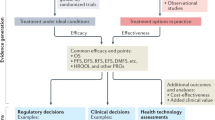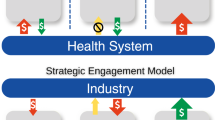Abstract
The cost of monoclonal antibody therapies for cancer is soaring out of control. Healthcare payers and patients are increasingly struggling to meet the high costs, which can be up to US$100,000 a year. A number of methods have been proposed to control these costs—government price controls on cancer drugs, biosimilars and novel drug pricing strategies. This article discusses what the impact of these strategies would be in terms of their ability to reduce costs and their effect on innovative cancer drug discovery.
This is a preview of subscription content, access via your institution
Access options
Subscribe to this journal
Receive 12 print issues and online access
$209.00 per year
only $17.42 per issue
Buy this article
- Purchase on Springer Link
- Instant access to full article PDF
Prices may be subject to local taxes which are calculated during checkout
Similar content being viewed by others
References
Kolata, G. & Pollack, A. Costly Cancer Drug Offers Hope, but Also a Dilemma. New York Times (July 6 2008) [online], (2008).
American Cancer Society. Cancer Facts & Figures 2007. American Cancer Society [online], (2007).
Chao, E. L. & Hall, K. National Compensation Survey: Occupational Earnings in the United States, 2007. Bureau of Labor Statistics [online], (2008).
DiMasi, J. A. & Grabowski, H. G. The cost of biopharmaceutical R&D: is biotech different? Manage. Decis. Econ. 28, 469–479 (2007).
Rucker, N. L. Biologics in Perspective: Expanded Clinical Options amid Greater Cost Scrutiny. AARP [online], (2007).
IMS Health. 2007 Top Therapeutic Classes by U. S. Sales. IMS Health [online], (2008).
IMS Health. Intelligence.360—Global Pharmaceutical Perspectives 2007. IMS Health [online], (2008).
American Cancer Association. Monoclonal Antibodies. American Cancer Association [online], (2008).
La Merie Business Intelligence. R&D Pipeline News: Top 20 Biologics. La Merie [online], (2008).
Giaccotto, C., Santerre, R. E. & Vernon J. A. Drug Prices and Research and Development Investment Behavior in the Pharmaceutical Industry. J. Law. Econ. 48, 195–214 (2005).
U.S. Department of Commerce. Pharmaceutical Price Controls in OECD Countries: Implications for U.S. Consumers, Pricing, Research and Development, and Innovation. International Trade Administration [online], (2004).
Generic Pharmaceutical Association. About Generics. Generic Pharmaceutical Association [online], (2009).
Congressional Budget Office. S. 1695 Biologics Price Competition and Innovation Act of 2007. Congressional Budget Office [online], (2008).
Danzon, P. M., Epstein, A. & Nicholson, S. Mergers and Acquisitions in the Pharmaceutical and Biotech Industries. Manage. Decis. Econ. 28, 307–328 (2007).
Generic Pharmaceutical Association. Biogenerics. Generic Pharmaceutical Association [online], (2009).
Biotechnology Industrial Organization. New Bipartisan, Consensus Bill Points to Right Path to Biosimilars. Biotechnology Industrial Organization [online], (2009).
Pharmaceutical Research and Manufacturers of America. PhRMA Statement on Rep. Eshoo's Follow-on Biologics Bill. Pharmaceutical Research and Manufacturers of America [online], (2009).
Biotechnology Industry Organization. How has Europe Approached Biosimilars? Biotechnology Industry Organization [online], (2009).
National Institute for Health and Clinical Excellence. Renal cell carcinoma—bevacizumab, sorafenib, sunitinib and temsirolimus: appraisal consultation document. National Institute for Health and Clinical Excellence [online], (2008).
National Institute for Health and Clinical Excellence. Sunitinib for the first-line treatment of advanced and/or metastatic renal cell carcinoma. National Institute for Health and Clinical Excellence [online], (2009).
HHS.GOV/Recovery. United States Department of Health and Human Services [online], (2009).
Bach, P. Limits on Medicare's Ability to Control Rising Spending on Cancer Drugs. N. Engl. J. Med. 360, 626–633 (2009).
National Institute for Health and Clinical Excellence. Press Release. NICE guidance on bortezomib (Velcade) is a win-win solution for multiple myeloma patients and the NHS. National Institute for Health and Clinical Excellence [online], (2007).
National Institute for Health and Clinical Excellence. Health and Clinical Excellence: The NICE Bulletin for Parliamentarians. National Institute for Health and Clinical Excellence [online], (2006).
Gavel, S. J. The Oncology Pipeline: Maturing, Competitive, and Growing? Oncology Business Review 2008 September. IMS Health [online], (2008).
Author information
Authors and Affiliations
Corresponding author
Ethics declarations
Competing interests
The author declares no competing financial interests.
Rights and permissions
About this article
Cite this article
Malik, N. Controlling the cost of innovative cancer therapeutics. Nat Rev Clin Oncol 6, 550–552 (2009). https://doi.org/10.1038/nrclinonc.2009.113
Issue Date:
DOI: https://doi.org/10.1038/nrclinonc.2009.113
This article is cited by
-
Anti-interleukin-6 therapy through application of a monogenic protein inhibitor via gene delivery
Scientific Reports (2015)
-
Cleaning-in-place of immunoaffinity resins monitored by in situ ATR-FTIR spectroscopy
Analytical and Bioanalytical Chemistry (2015)
-
Clinical Experience of the Use of CT-P13, a Biosimilar to Infliximab in Patients with Inflammatory Bowel Disease: A Case Series
Digestive Diseases and Sciences (2015)
-
Cost-analysis of XELOX and FOLFOX4 for treatment of colorectal cancer to assist decision-making on reimbursement
BMC Cancer (2011)



